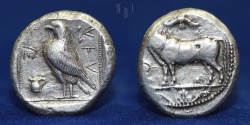Lot 6: Cyprus, Paphos AR Stater. Stasandros, circa 425 BC or later 
AUCTION: NBJ E-Auction 2, Ancient and Islamic Coins (Auction 360)

- Starting Bid: $1,800
- 0 Bid(s)
Cyprus Paphos AR Stater. Stasandros, circa 425 BC or later. Bull standing to left; winged solar disk above, ankh to left, palmette ornament in exergue / Eagle standing to left; one-handled vase to left, 'pa-si sa-ta-sa' in Cypriot script around; all within dotted square in incuse square. Weight : 11.05 gm. Size : 22 mm. Near Extremely Fine. Very Rare. Paphos was a city of great antiquity, occupied since the Neolithic period and venerated as the place where Aphrodite came to shore after rising from the sea; the grove and altar at Paphos are mentioned in the Odyssey (viii.362). As with all of the early Cypriot coinage, the chronology of the kings (whose names are frequently not given in full, and even then only in Cypriot syllabic) of Paphos is far from certain. However, in a thorough analysis of this mint and inscriptions, A. Destrooper-Georgiades (Le monnaies frappées à Paphos (Chypre) durant la deuxième moitié du Ve siècle et leur apport à l'histoire de l'île"" in Proceedings of the 12th International Numismatic Congress, Berlin 2000, pp. 194-8), proposes a sequence of kings based on the available numismatic evidence which securely places Onasioikos prior to the reign of Stasandros, who is in turn succeeded by at least two other kings, Mineos and Zoalios, who are known to history only from their inscriptions on re-engraved coins of Stasandros. The evidence presented by Destrooper-Georgiades demonstrates with a high degree of probability that the issues attributed to Onasioikos bearing the flying eagle reverse (generally dated to 400 BC without supporting evidence) are in fact an earlier issue of the same king named on the present type, and that his flying-eagle coinage should clearly be redated to before the reign of Stasandros. The archaistic appearance of Onasioikos' flying-eagle type weighs heavily in favour of this, since a backwards step from classical style to archaic is counter-intuitive. Furthermore, the style of the standing-eagle reverse type of Onasioikos is so similar to archaic style issues of Stasandros, that it appears to conclusively demonstrate that this king Onasioikos was the immediate predecessor of Stasandros, since the latter retained the same types for his first coinage; this theory is supported by the difference in style between the issues of Stasandros: the 'earlier' issue being distinctly archaic in appearance, while the 'later' issue is more classical in style. Destrooper-Georgiades proposes a revised dating of circa 450 BC for the flying-eagle type of Onasioikos, and a period from the mid-fifth century to the first decades of the fourth century for the standing-eagle coinage of Onasioikos, Stasandros, Mineos and Zoalios.
- Offered By: BIN JASSIM TRANS GLOBAL LLC
- Lot #: 6
- Listing #: 220090
- Closed: Friday, April 23, 2021 4:01:40 PM CT
- Estimate: $3,500

